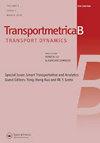车联网环境下基于drl的总线优先服务自适应信号控制
IF 3.4
2区 工程技术
Q2 TRANSPORTATION
引用次数: 0
摘要
本文章由计算机程序翻译,如有差异,请以英文原文为准。
DRL-based adaptive signal control for bus priority service under connected vehicle environment
Transit Signal Priority (TSP) strategy gives public transit vehicles privileges to pass through the intersection without stopping. Most previous studies have adopted the compulsory TSP strategy that considers to maximize the utility of public transportation, which is likely to reduce the efficiency of social vehicles. In this paper, we propose an Adaptive Transit Signal Priority (ATSP) model that considers the efficiency of both buses and social vehicles. This model has the Single Request Adaptive Transit Signal Priority (SR-ATSP) module and the Multi-Request Adaptive Transit Signal Priority (MR-ATSP) module. First, the intersection network is divided into grids based on the Discrete Traffic State Encoding (DTSE) idea to obtain the spatial information of vehicles. Then, in the SR-ATSP module, the Dueling Double Deep Q-learning Network (D3QN) algorithm is introduced to determine whether to implement the TSP strategy or not, considering the goal of minimizing the total passenger waiting time of buses and social vehicles. Based on the SR-ATSP, the MR-ATSP module introduces some rules to tackle the conflict from multiple priority requests of different buses. Simulation experiments based on an intersection in Nansha District, Guangzhou City are conducted on SUMO software. The results show that the proposed ATSP model can realize the priority treatment for of buses while reducing the waiting time of social vehicles by . It has superior performance for reducing the waiting time of buses and social vehicles than other widely-used TSP models.
求助全文
通过发布文献求助,成功后即可免费获取论文全文。
去求助
来源期刊

Transportmetrica B-Transport Dynamics
TRANSPORTATION SCIENCE & TECHNOLOGY-
CiteScore
5.00
自引率
21.40%
发文量
53
期刊介绍:
Transportmetrica B is an international journal that aims to bring together contributions of advanced research in understanding and practical experience in handling the dynamic aspects of transport systems and behavior, and hence the sub-title is set as “Transport Dynamics”.
Transport dynamics can be considered from various scales and scopes ranging from dynamics in traffic flow, travel behavior (e.g. learning process), logistics, transport policy, to traffic control. Thus, the journal welcomes research papers that address transport dynamics from a broad perspective, ranging from theoretical studies to empirical analysis of transport systems or behavior based on actual data.
The scope of Transportmetrica B includes, but is not limited to, the following: dynamic traffic assignment, dynamic transit assignment, dynamic activity-based modeling, applications of system dynamics in transport planning, logistics planning and optimization, traffic flow analysis, dynamic programming in transport modeling and optimization, traffic control, land-use and transport dynamics, day-to-day learning process (model and behavioral studies), time-series analysis of transport data and demand, traffic emission modeling, time-dependent transport policy analysis, transportation network reliability and vulnerability, simulation of traffic system and travel behavior, longitudinal analysis of traveler behavior, etc.
 求助内容:
求助内容: 应助结果提醒方式:
应助结果提醒方式:


